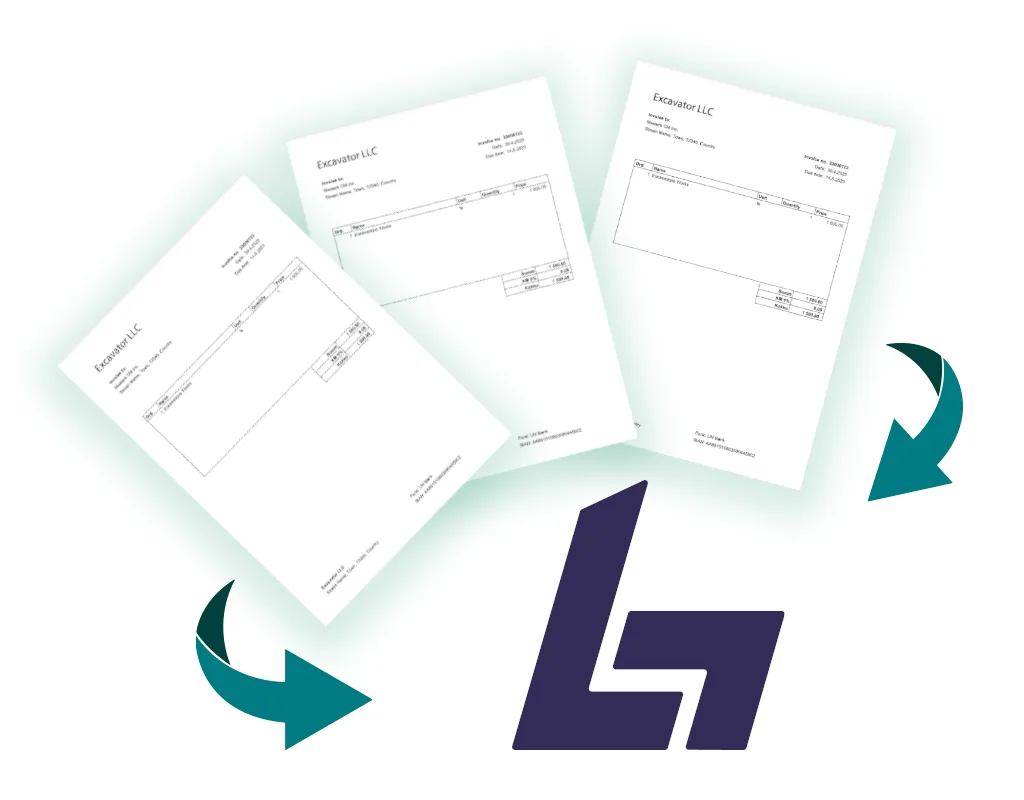Accurate and prompt invoicing is vital to effectively managing your company’s accounts receivable. With high overhead costs, slow payment practices, and the industry’s typical reliance on credit, financial difficulties are easy to face. By ensuring your construction invoices are both precise and timely, you can speed up your payment process and prevent the critical problem of running out of cash.
Table of Contents
What is a Construction Invoice?
A construction invoice is a document sent by a contractor, subcontractor, or supplier to their client to request payment for work completed. This document sets up a payment duty, thus creating an account receivable, which is simply a record of money that someone owes you. Invoices are crucial as they help maintain the cash flow within the business.
Details typically included in a construction invoice are:
- The date the invoice was issued
- Names and addresses of both the sender and the recipient
- A description of the goods and services provided
- The pricing and quantities of the goods and services
- Payment terms
The specific details on a construction invoice can vary greatly, depending on the nature of the work performed and how a particular construction business manages its billing.
What Are Not Invoices?
While there are documents that are often used alongside or in place of invoices, they are not substitutes for an invoice itself.
Payment Applications
Payment applications are documents used when a payment has been made and must be applied to an account balance. These often consist of documents that provide the necessary details to authorize payment releases. For contractors or subcontractors, payment applications might include invoices from various sub-tier businesses and vendors.
Purchase Orders
Purchase orders are documents created before any transaction. They record what the customer intends to buy and are part of the transaction approval process. In contrast, invoices are issued to request payment for goods or services after they have been delivered, reflecting the terms agreed upon in the purchase order.
Verbal Communications
Verbal communications or requests do not count as invoices. While it might seem obvious, having written payment requests is crucial. Although substantial payment discussions can occur in person, over the phone, or via text, it is essential to have a written record that a payment was requested, especially to address any potential disputes or misunderstandings that may arise during the job.
Construction Invoicing Best Practices
Every construction business develops its own invoicing methods, and most know what strategies work best for them. However, there’s always an opportunity to enhance these practices. Below, you’ll find some recommended best practices for improving construction invoicing.
1. Start with a basic invoice template
When making an invoice, choose a basic template with all the necessary details and meet standard practices. The template should list your business’s name, logo, address, and contact information, along with similar details for the client, including their name, address, and contact info. Also, include the invoice number, date, due date, project details like name, description, location, contract type and number, payment terms and methods, and a detailed breakdown of services, materials, and labor used. Include a subtotal, taxes, discounts, retainage (if applicable), and the total amount due. Add any notes, attachments, or signatures that are relevant. A basic template helps streamline your invoicing process, minimize mistakes, and maintain a professional and consistent approach.
2. Invoice according to the terms of the contract
Following the invoicing guidelines set in your contract with your client is crucial. This includes how often you send invoices, the invoice layout, and how you should send them, along with details about payment deadlines, project milestones, modifications, withheld payments, and how to handle disagreements. Make sure to invoice only for work that the client has approved. Attach any documents like progress updates, receipts, lien waivers, or completion certificates that support your work and help smooth the payment process.
3. Keep accurate records of your time and costs
An essential tip for effective invoicing is to keep precise and clear records of your time and expenses. This ensures that you bill the right amount, preventing undercharging and overcharging, and allows you to explain your charges to your client clearly. Use trustworthy software to track your hours, tasks, rates, and expenses and to produce comprehensive reports that you can include with your invoices. It’s also important to inform your clients about your ongoing time and costs and alert them to any changes or unexpected shifts in the budget or project scope.
4. Send your invoices quickly and online
A good invoicing practice is sending your invoices quickly and using electronic methods. Sending invoices right after completing a milestone, phase, or the entire project, or as scheduled, can lead to faster payments and better cash flow while helping you avoid any late fees. It’s best to send invoices through email or an online invoicing service. This method speeds up the process, reduces paper use, and often allows for online payments. Make sure to confirm that your client has received and looked over your invoices and follow up if needed.
5. Maintain Detailed Records
In the construction industry, keeping detailed documentation is essential. As a contractor or subcontractor, you are paid based on the work you can prove through documentation, not just your work. Keep an organized record of everything related to your projects to ensure you’re prepared for any payment disputes. This includes all receipts, timesheets, and any other relevant documents. These records are crucial for validating your submitted invoices and resolving any issues regarding prices and payment terms. Always document your activities and maintain these documents throughout the project to support your claims and facilitate smooth payment processes.
6. Use an Invoice Management Software
An invoice management system is software designed to help you create, manage, and track invoices online. It works on any device connected to the internet, simplifying work management and accelerating the payment process. These systems typically provide features that allow you to monitor invoice statuses and view your payment history, helping you manage your business finances effortlessly. If you want a smoother invoicing process, consider using invoice management software.
Many contractors are now using these systems to produce custom invoices quickly from anywhere, streamlining their project management and facilitating faster payments. One significant advantage of using an IMS is receiving payments directly via email in real-time, eliminating the delay typically associated with waiting for checks. Additionally, an IMS securely stores all your customer contacts and documents, making it easy to maintain records of past clients and reach out to them for future jobs. This ensures that your invoicing and client management are both efficient and organized.
7. Follow Invoicing Laws and Regulations
A critical practice for invoicing is to make sure you follow the invoicing laws and regulations relevant to your construction project. These laws can vary by state, county, or city, influencing how you should handle invoicing, the processes you need to follow, and your legal rights. It’s important to learn about the invoicing-related laws that apply to your project, including prompt payment laws, lien laws, tax regulations, and consumer protection statutes. Ensure that your invoices comply with these legal requirements. If you’re unsure about any aspect of invoicing compliance, consider consulting with a legal or accounting expert to get the proper guidance.
8. Send Invoices Promptly
Last year, only 8% of contractors reported that their customers consistently paid on time. To avoid payment delays, sending out your invoices as soon as possible is crucial. Delayed invoices often result in late payments and can confuse them, especially if too much time has passed since the work was completed. Ensure that invoices are sent while the details of the work are still fresh in everyone’s minds.
It’s important for subcontractors to submit their invoices and all necessary documentation promptly. This helps the main contractor to bill the customer accurately and without delays. Start each project with clear communication about what documents are needed and the timelines for the billing process. Improving how you communicate internally and manage your billing can help speed up the process of sending invoices to customers. This approach emphasizes the importance of taking invoicing seriously to avoid confusion and ensure timely payments.
9. Set Clear and Reasonable Payment Terms
When arranging how you’ll bill your client, make sure both of you understand exactly when and how payments will be calculated. Avoid any vague terms that could cause confusion or problems later on.
Although it’s common in the industry to allow 30 days for payment, and some large companies might stretch this to 120 days, shorter payment terms can be beneficial, especially for smaller businesses. Long payment durations can increase debt and negatively impact financial health. Considering this, some small—to medium-sized construction businesses opt for a 7-day payment period to maintain a steady cash flow.
While a 7-day term is much quicker than the standard, and you might not always get payment that fast, don’t hesitate to negotiate better terms. Avoid agreeing to lengthy payment periods that could strain your finances. Building a trustworthy and cooperative relationship with your client can help you achieve more favorable payment terms.
10. Maintain Clarity and Consistency in Your Invoices
- Consistent Formatting: Make sure all your invoices follow the same format. This consistency helps prevent errors and makes comparing information across different billing periods easier.
- Clear and Detailed Descriptions: Misprints or miscommunications are common causes of disputes. Always include clear payment instructions and terms on your invoices to minimize errors.
- Balanced Detailing: Your invoices should be precise yet detailed enough so clients understand exactly what they are paying for. Provide sufficient information to justify the charges, but keep it concise to avoid clutter. Standardizing the format and labeling of work or products not only helps maintain organization within your business but also clarifies billing for your clients. Adding professional touches like uniform labels or formats across all documents can enhance the readability and professionalism of your invoices.
Additionally, always reference the initial quote or estimate in your invoices to ensure there are no discrepancies between what was quoted and what is being billed. This not only helps in clear referencing but also in justifying the pricing to the client.
11. Implement Early Payment Incentives and Late Payment Penalties
Offering incentives for early payments or imposing penalties for late ones can be effective ways to ensure timely payments. About 43% of companies use such methods to speed up the payment process. For instance, you could offer a discount for invoices paid before the due date, which can encourage faster payment. On the other hand, applying penalties for late payments can also prompt clients to prioritize settling their bills on time.
However, it’s important to consider the financial impact of these incentives. While discounts can accelerate payments, they also reduce your profit margins. In industries like construction, where margins are already tight, it’s crucial not to undermine your financial stability with excessive discounts. As for penalties, they help encourage timely payments but should be applied carefully to avoid damaging client relationships. Always ensure that the terms for both incentives and penalties are reasonable and communicated in your invoices to avoid any confusion and maintain good client relations.
12. Follow Up on Unpaid Invoices Actively
Don’t hesitate to follow up on unpaid invoices. It’s important to be proactive because invoices can easily be overlooked, lost among other paperwork, or even ignored by clients. Make regular follow-up calls or send emails to ensure that your invoices get the attention they deserve and that you receive the payment you’ve earned. If an invoice remains unpaid, initially reaching out to discuss it with the client can be more effective than immediately demanding payment.
13. Consider Automating Your Invoice Follow-Up
Automating your invoice follow-up process can streamline your efforts and ensure consistent communication with your clients about unpaid bills. Like anyone else, your clients might delay payments for various reasons—invoices can get misplaced, forgotten, or buried under other bills. Automated reminders help keep your invoices at the forefront of your clients’ minds, providing them with the payment details they need, especially if the original invoice was missed. Automated follow-ups can motivate clients to clear their dues quicker and free up your billing department from the manual task of sending reminders.
Handling Unpaid Invoices in Construction
Even if a construction business does everything correctly, there might still be issues with getting paid. Here’s what to do if your invoices go unpaid:
Follow-up on the Invoice
First, do not ignore the issue. It’s perfectly normal to follow up on an unpaid invoice. Many customers will be willing to discuss why there has been a delay in payment. This conversation can help both parties understand the cause of the delay, how long it might take to resolve it, and what further steps may be necessary. It’s wise to attempt to follow up a few times before considering more serious measures.
Payment Demands
If polite reminders do not result in payment, it may be time to make a formal payment demand. This doesn’t mean jumping straight to legal threats. One effective approach is to send a notice of intent to lien. This lets your customers know you are serious about getting paid and lets them settle the matter before you take legal action or file a lien claim. However, be cautious with this approach, as customers and owners often react negatively to the threat of a lien.
If necessary, you can escalate to sending a payment demand letter through an attorney, mentioning possible legal actions such as claims for breach of contract, prompt payment violations, or issues with retainage. Such letters are more persuasive and can strongly encourage customers to settle their debts, especially when they know the claim is backed by solid documentation.
Streamlining Invoice Review and Approval in Construction
In an ideal world, subcontractors and suppliers would always submit precise invoices matching the hours worked and agreed-upon rates. However, contractor invoices often contain errors, duplications, or fraudulent activities. Implementing a thorough invoice review and approval process is vital for protecting your construction company’s finances.
1. Verify the Work
Ensure that the work invoiced has been completed and meets the required standards. Sometimes, invoices are issued before the work starts, or the quality might be subpar. Before approving payment, inspect the work and consult the contract documents to confirm that the work was authorized and not done by unauthorized parties. If the work isn’t up to standard, hold off on payment until corrections are made.
2. Check for Duplicate Payments
Double billing is a frequent issue in construction payments. While it’s often an innocent mistake, sometimes it might be intentional, hoping the busy office staff will overlook it. Pay close attention to the work descriptions and dates on the invoice, and make sure these charges haven’t appeared on previous invoices. It’s crucial never to pay for the same job twice.
3. Review Supporting Documents
The reliability of an invoice heavily depends on its supporting documents. These might include receipts, daily progress reports, timesheets, payroll records, and other relevant documentation that verifies the work and hours billed are accurate. Checking these documents might seem tedious, but it is essential for ensuring invoice accuracy.
4. Confirm Business Contact Information
Always verify the subcontractor or supplier’s business information for any discrepancies. Check the business name, address, and tax ID number against the contract documents to ensure they match. Differences might be due to simple errors or changes like ownership that could affect where payments are sent.
By improving the invoice process, the construction industry can facilitate quicker payments and reduce the likelihood of disputes. To stay updated on best practices in billing procedures, consider following a construction payment blog or consulting with industry experts.
Related posts
Read our other articles where you can find useful and relevant information about construction invoicing:
About the Author

Taavi Kaiv
Taavi Kaiv is a construction specialist with over ten years of experience in the construction industry. Taavi is an accomplished construction project manager with many successful projects that have been completed under his guidance. Taavi holds a master’s degree in construction management from the Tallinn University of Technology. View profile





